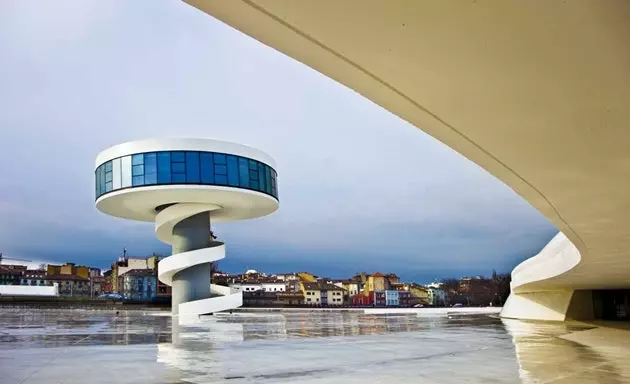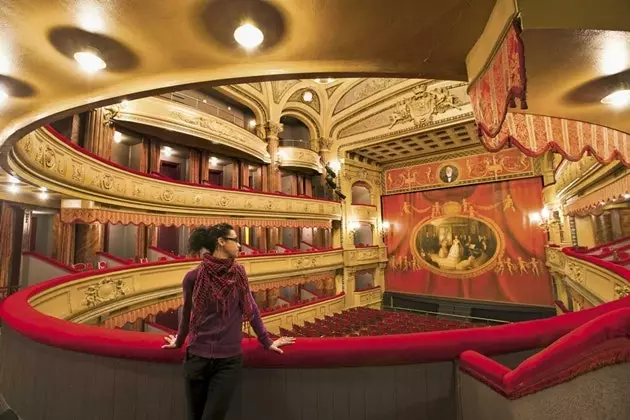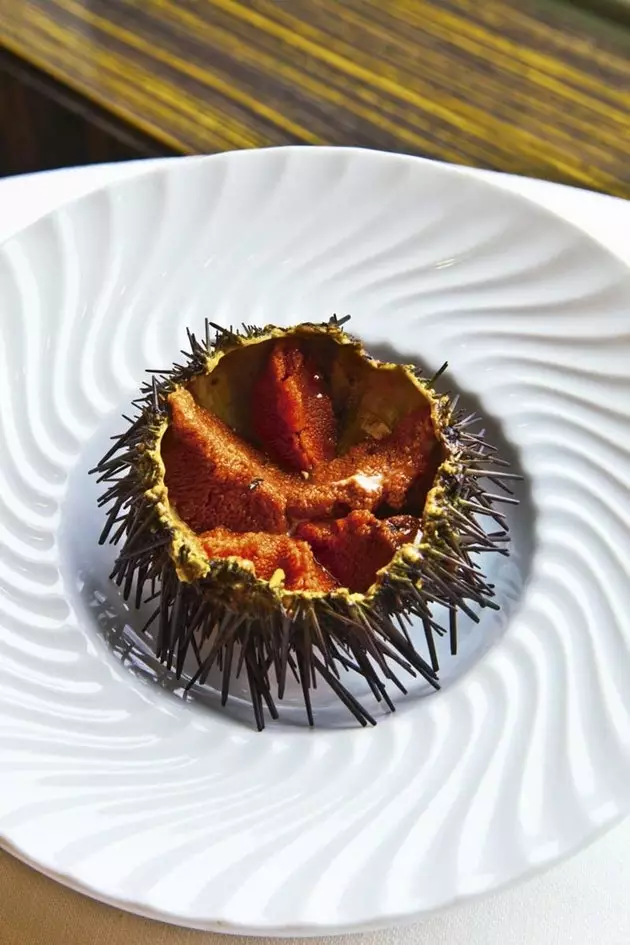
Niemeyer Center Tower
Something happens in Avilés when talented people such as Woody Allen, Norman Foster, Oscar Niemeyer or Carlos Saura have agreed to come to work here. Something has the wine when they consecrate it. And the vintage is good. Woody Allen doesn't have much merit. It's already home. He has come to Asturias six or seven times. In Avilés he presented the world premieres of 'Cassandra's dream' and 'You will meet the man of your dreams'. He changed the plot of 'Vicky, Cristina, Barcelona' so that the town intervened in the plot. They still call from Brazil and the US asking the concierge at the Palacio de Ferrera hotel about the nightly concerts in the French Garden like the ones in the movie.
Woody Allen assures that if he does not retire in Manhattan he will do so in Asturias, although nobody wants him to retire. The British Norman Foster took over the Innovation Island project , perhaps the most ambitious of those facing the country. The transformation of 575,000 m2 of the Avilés estuary dedicated to heavy industry since the 1950s into a setting for the good life – a marina with a cruise terminal, lofts for artists, architectural cubes for technological and cultural uses, a large boulevard– that gravitates around the jewel in the crown, the Oscar Niemeyer International Cultural Center.
Here appears the figure of the Brazilian architect. The city's bold modernizing turn is led by a 103-year-old genius. And he still smokes. A guy who, when he explains the main lines of the auditorium, for example –which together with the dome, the tower, the multipurpose building and the square open to the estuary make up the complex's five spaces–, talks about acoustics and visibility, normal concepts that some 'star' architects turn into paranormal. The Niemeyer Center is his main work in Europe and the architect has given it to Asturias.

Interior of the Palacio Valdés Theater
The inspiration for his latest work? The curves of the Brazilian woman. In fact, there are only three straight walls in the entire center (look for them, like Wally). Avilés premieres them on March 26. The first who wanted to see so much voluptuousness was Brad Pitt . The actor, a good fan of architecture, appeared by surprise in Avilés. “He arrived without warning and within a few hours there were already hundreds of fans at the door of the Palacio de Ferrera. Brad – he calls him by his first name – had to leave the Niemeyer camouflaged in the car of a construction worker”, says Natalio Grueso, director of the Center.
His mobile phone is worth a Congo. On the agenda are the names of Sam Mendes, Kevin Spacey, Stephen Hawking, Vinton Cerf, Woody Allen himself... all of them will participate in one way or another in Niemeyer. Because the challenge starts now. “The goal is for this emblematic work to become a space of creation and freedom . One of its pillars will be the production and export of its own content. Links with the Guggenheim in Bilbao are inevitable. It is a signature building that by itself is capable of regenerating an urban space.
But "the Niemeyer is not a museum, It is a place where all the arts have a place ”, He explains to me next to a photograph of Oscar Niemeyer (smoking) in the Center's offices at the Palacio Valdés Theater, a splendid Italian-style theater that was built when Avilés had 12,000 inhabitants. Carlos Saura signs the inaugural exhibition of the Niemeyer, of a multidisciplinary nature, entitled The light. “Avilés is a paved town,” a countryman armed with a beret and a hazelnut stick tells me sarcastically on Ruiz Gómez street. Why not. But he tells me in a modernist street that connects the historic center, declared a Historic Artistic Site, with the Niemeyer Center, the only intervention of the Brazilian architect in Spain.
On a magical walk that takes you in just 500 meters from the medieval city, one of the best preserved in Spain and where it smells of firewood on rainy days, to the architecture of the 22nd century. And how well you eat. In the 17th century arcades of the painterly Calle Galiana is call , led by Eva in the dining room and Fran in the kitchen, a young and virtuous chef who has worked with Ferran Adrià at El Bulli and Sergi Arola at the arts . Snacks and dishes to share such as stewed rice with foie and sea urchins.

Holes at Casa Gerardo
A few steps further up, in Plaza del Carbayedo, is Casa Tataguyo. His longaniza is mythical. Brad – let's call him Brad – wanted to give a good account of her as he passed through Avilés. If what you are looking for is a classic cider house with sawdust on the floor and poured cider in the air, nothing like Lin House. For those with a sweet tooth, the first woman to become mayor of Avilés, Pilar Varela, recommends the Vidal Confectionery.
Michelin star restaurants are located in the outskirts of Avilés. Koldo Miranda personifies the metamorphosis of Avilés. He embodies the roadmap that the city is pursuing: from polluting heavy industry to cutting-edge exercise. In the case of Koldo, gastronomy. His parents came from the Basque Country to work at Ensidesa and he grew up in Asturian kitchens until he achieved Michelin stardom in 2006. The 'ear', that catchphrase so typical of chefs, escapes him even when he drives. He speaks enthusiastically of the cuisines of Peru and Japan. When he does it, he doesn't speak, he gives cooking workshops (in fact, he teaches them); and he doesn't eat, he devours. he has found an author's niche in Creole cuisine : “My cuisine worships the Nikkei (Japanese-Latin), Amazonian and Chifa (Chinese-Peruvian) traditions”. The Koldo Miranda Restaurant occupies an old Asturian country house from the end of the 18th century in La Cruz de Illas, Castrillón, four kilometers from Avilés, where the chef lived for years.
In the sandy area of Salinas he runs the Ewan Food , a gastrobar with a modern air. And the Asturian bean stew? At Gerard's House. Pedro and Marcos Morán prepare some Michelin star beans as voluptuous as the curves of a woman from Rio de Janeiro.
This report was published in issue 38 of Traveler magazine.
